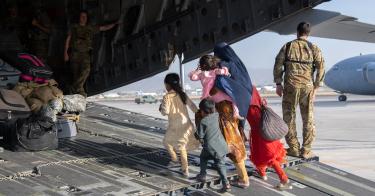The Senate Foreign Relations and Armed Services committees are scheduled to receive closed-door testimony at the end of this month from Secretary of State Antony Blinken and Defense Secretary Lloyd Austin about the withdrawal from Afghanistan. Here’s hoping at least one committee member will ask: Where was the Air Force?
Afghanistan is a landlocked country. The evacuation was always going to be done by air. After months of detailed planning designed to ensure that every American citizen, service member and at-risk Afghan ally—as well as the bulk of critical military equipment—was safely airlifted out of the country, how could things have gone so poorly?
The Defense Department has a reputation as being “best in class” when it comes to developing and executing contingency operations. Typically, it develops for decision-makers three to four alternative courses of action to bring a situation to a favorable end.
Each alternative differs based on an increasingly challenging risk or threat level. The first normally assumes the most favorable environment and the last the most extreme, but every plan that is presented to decision-makers is designed to accomplish the intent, required tasks and specified goals of the operation.
>>> Biden’s Lies and Their Consequences in the Fall of Afghanistan
In the case of Afghanistan, planners even had a similar, historic operation from which to learn: The 1975 evacuation from Vietnam. The only major difference: Unlike Vietnam, Afghanistan has no seaport access. Clearly, all the people and equipment would have to be flown out. That should have put U.S. Airmen on point to plan and execute the meat of the operation.
The greatest U.S. asset in Afghanistan was Bagram Air Base, located just 30 miles north of the U.S. Embassy in Kabul. A secure facility with two 9,000+ foot long runways, the base was well equipped to lodge, feed and process large movements of personnel and equipment. At the height of the war, it housed and fed more than 40,000 personnel.
It is inconceivable that any planned course of action for withdrawal did not rely almost wholly on our access to Bagram. So how was the decision taken to abandon this all-important airfield four weeks before the surge in evacuations began? Surely the Air Force’s three- and four-star generals—senior airmen with decades of experience—knew just how disastrous such a move would be. How could they allow it?
This unfathomable blunder would force the evacuation to shift to Karzai International—an airfield in disrepair, with but a single runway and no air traffic control radar, no food and no lodging facilities. Moreover, it is located in the kind of urban environment guaranteed to make it a nightmare to secure.
Not to put too fine a point on it, Karzai International was wholly unsuited for any aspect of the evacuation. Relying on it for the meat of the airlift would put the success of every goal of the operation into question.
Could the secretary of Defense or the chair of the Joint Chiefs of Staff have made an unflinching stand against the decision to close Bagram?
You bet they could.
But senior airmen were also in a position to know better than anyone else that an evacuation from Karzai International would be an unmitigated disaster—not just a public affairs nightmare, but a full-blown debacle that would likely result in the loss of American lives.
Was no one willing to put their career on the line to try and stop that train wreck from happening? Someone, to take a principled stand against this madness, even though the odds are high that you’d be replaced immediately by someone else who would support the move?
Apparently not. No one was fired and, even in the operation’s aftermath, no one resigned, which speaks volumes.
>>> Afghans Need Our Help. Will the Biden Administration Step Up?
By not standing firm against the closure of Bagram Air Base, our senior leaders allowed more than 1,000 American citizens, tens of thousands of Afghan allies and hundreds of millions of dollars in military equipment to be left behind.
And by agreeing to rapidly abandon Bagram, the doors were allowed to swing open at Panwar Prison—the on-base detention facility holding between 5,000 and 7,000 enemy combatants. Those prisoners were let free while U.S. personnel were still in-country.
The suicide bomber who killed 13 American service personnel and dozens of hopeful Afghans at the gate at Karzai International Airport had been held in that prison. He would have been in jail until well after the last flight had left the country, had we held on to Bagram. Instead, he was set free.
The saying goes “to whom much is given, much will be required.” Our young sailors, soldiers, airmen and marines willingly put their lives on the line to meet those expectations in Afghanistan. It is a shame our senior leaders were not willing to do the same thing with their careers.
This piece originally appeared in The Washington Times



